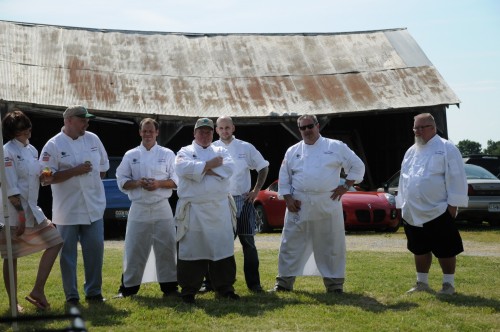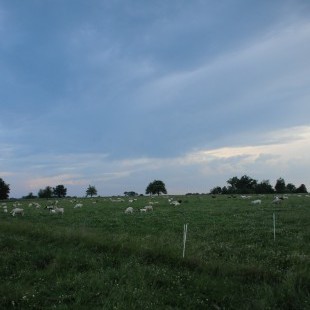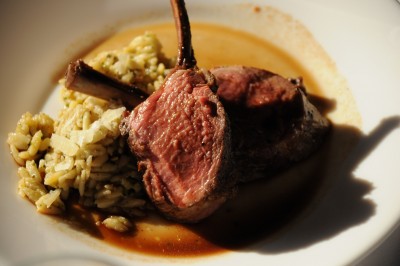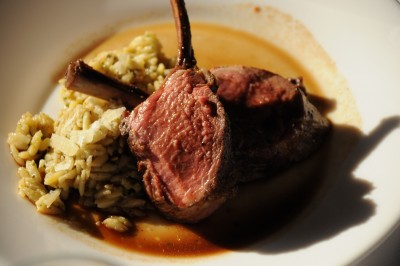 The chefs of “Lambstravaganza.”The best part about my work with Slow Food USA is getting to experience new people, places, and especially great foods. Such was the case this past weekend as I traveled to join the members of Slow Food St. Louis for their fourth annual “Lambstravaganza” at Prairie Grass Farms just outside of New Florence, Mo.
The chefs of “Lambstravaganza.”The best part about my work with Slow Food USA is getting to experience new people, places, and especially great foods. Such was the case this past weekend as I traveled to join the members of Slow Food St. Louis for their fourth annual “Lambstravaganza” at Prairie Grass Farms just outside of New Florence, Mo.
Prairie Grass Farms is in the capable hands of its third generation of Hillebrands. Dave Hillebrand runs the farm now, having inherited it from his father and grandfather before him. There they used to raise primarily row crops, but Dave took an interest in chickens–and eventually in his grandfather’s sheep. Today he and his family raise about 700 lambs a year on their 520 acres, all of it on scrupulously-cared-for prairie grasses (hence the name).
Hillebrand insists that everyone’s health — yours, mine, his, the sheep’s, the earth’s — is tied directly to the soil and to the interaction of plant, animal, and microorganisms in and on it. This philosophy is keeping his family on the farm without resorting to the trap of concentrated animal feeding operations (CAFOs) that so many Midwest farmers have come to consider their only resort. Those CAFOs are just the opposite of Hillebrand’s methods: they take everything from the earth and give back only pollutants in the form of concentrated manure.
 Sheep grazing at Prairie Grass Farms.Sheep and other livestock (he has a few head of cattle and his daughter tends the goats), when allowed to graze free in the pasture, aerate and fertilize the soil constantly. In return, the sheep get plenty of sweet grass and clover, packed full of healthy nutrients that they in turn convert to good milk for the lambs. Chickens remove worms, grubs, and other pests from the soil, add additional fertilizer, and provide the best eggs you’ve ever tasted in a rainbow of colors.
Sheep grazing at Prairie Grass Farms.Sheep and other livestock (he has a few head of cattle and his daughter tends the goats), when allowed to graze free in the pasture, aerate and fertilize the soil constantly. In return, the sheep get plenty of sweet grass and clover, packed full of healthy nutrients that they in turn convert to good milk for the lambs. Chickens remove worms, grubs, and other pests from the soil, add additional fertilizer, and provide the best eggs you’ve ever tasted in a rainbow of colors.
It takes a ratio of about seven to nine ewes and their lambs to each acre of land for all the participating organisms to thrive. Those lambs go to members of Fair Shares CCSA and to some of the best restaurants in St. Louis. Nine chefs from those restaurants were present last Sunday to display their talents and celebrate the Hillebrand family’s hard work and dedication to sustainability.
Their tasting menu (eight small plates) was a testament to the tremendous quality of the meat. Vegans, you may want to skip this next part. Omnivores, get a load of this:
- Potted lamb with an assortment of housemade pickles by Margaret Kelly and Dave Owens of Bissinger’s Handcrafted Chocolatier
- Vindaloo braised shanks and toasted naan with pepita-coriander pesto and a mango lassi by Andy White of the Schlafly Tap Room
- Grilled leg of lamb & homemade feta with crispy mint gremolata and a shaved radish salad by Josh Galliano of Monarch
- Chermoula-spiced smoked lamb with harissa and a saffron aioli by visiting chefs Timothy Grandinetti and Ray “Dr. BBQ” Lampe
- Lamb’s tongue faggotini with consommé and cocoa nibs by Gerard Craft of Niche
- Rack of lamb by Lou Rook of Annie Gunn’s
- Lamb loin and sweetbreads by Kevin Nashan of Sydney Street Café
- Pistachio cream puff with farmers market strawberries, homemeade jam, and local honey by Christy Augustin, also of Sydney Street Café
If you’ll be in the area a year from now, you can participate in the 5th Lambstravaganza by getting on the Slow Food St. Louis listserv and getting your tickets as soon as they go on sale.
In the meantime, here’s a delicious and easy preparation of chops from your local source for lamb. It appeared in my latest book, and is by Chef Jasper Mirabile of Jasper’s in Kansas City.
Grilled Grass-Fed Lamb Chops
Jasper writes: Every summer my Nana (Jasper’s Grandmother) would prepare these delicious little chops on the grill. She would marinate the chops in balsamic and garlic and a little bit of red pepper. My three brothers and I would eat the chops faster than my dad could grill them!
Ingredients:
2-3 lamb racks (about 3 pounds, or 12 chops)
1 lime
½ cup extra virgin olive oil
2 tablespoons brown sugar
Salt to taste
5 tablespoons balsamic vinegar
4-5 sprigs fresh mint
2-3 cloves garlic, sliced paper thin
½ cup mint jelly
Procedure:
One day ahead: If your butcher hasn’t already, cut the racks into chops, using a cleaver if necessary to separate the chine bone. Lay out the chops in a shallow casserole. Drizzle the juice from the lime on the chops.
Mix the brown sugar, salt, and balsamic vinegar with half of the olive oil. Chop 2 of the mint sprigs coarsely and add to this marinade. Pour the marinade over the chops, turning each to get them thoroughly coated. Marinate in the refrigerator overnight.
Day of service: First thing in the morning, turn each chop once so that they marinate evenly.
A note about your grill: Gas grills are adequate, and need to be heated roughly half an hour in advance. Real wood always brings better flavor, though. I recommend using real wood charcoal, not briquettes. A good source for this is Cowboy Charcoal from Brentwood, Tenn. A charcoal fire needs about an hour to reach that white-ashed glow that’s perfect to cook on.
While the grill is warming up, mix the rest of the olive oil with the mint jelly and garlic.
Place the chops on the grill, being careful not to crowd your surface area. Grill them in batches if necessary. Baste each side with the mint sauce (Nana used to use a mint sprig to baste with). Cook approximately 5 minutes on each side, or to desired doneness. Serve immediately with remaining basting sauce for dipping.
Serves 6


